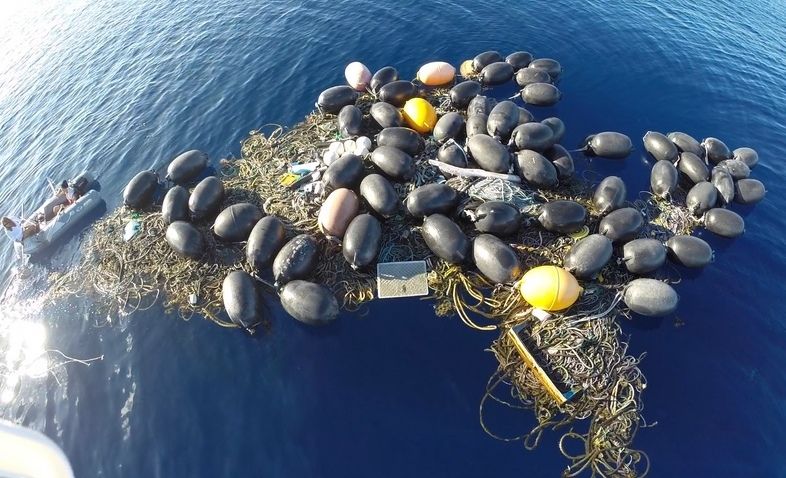
The world's oceans may contain about 10 times more plastic than the most recent studies suggest.
The new figure estimates that the oceans hold more than 250,000 tons of trash, a number vastly different from a past estimate, which suggested the oceans' plastic is mysteriously disappearing.
Scientists arrived at the new number by combining visual estimates of trash volume with data collected from trawling the oceans with nets, said study co-author Markus Eriksen, director of research for the 5 Gyres Institute, an organization aiming to understand the plastic pollution in the ocean. [See Images of Garbage in the Ocean]
World of plastic
The detritus of everyday life has been pouring into the oceans for decades. Everything from plastic bags to water bottles have migrated from the coastlines, harbors and river mouths into the oceans, where gyres, or the ocean's giant conveyor belts, carry them to the most remote stretches of the seas.
About 15 years ago, scientists discovered the Great Pacific Garbage Patch, a trash-filled region of the Pacific Ocean the size of Texas. A recent excursion even found that islands of trash were forming in the garbage patch.
In the 1970s, studies suggested that about 45,000 tons of plastic littered the ocean, and the world's production of plastic has increased fivefold since then. But scientists don't agree on just how much of the world's plastic makes its way into the ocean, or how long it lasts before fish, sunlight and currents break it down and carry it into the deep ocean. In dozens of expeditions, scientists have tried to estimate this number by visual counts or by trawling the seas with nets.
Sign up for the Live Science daily newsletter now
Get the world’s most fascinating discoveries delivered straight to your inbox.
But the first method is better at picking up large objects, such as buoys and fishing nets, whereas the second method may be more reliable for tiny, broken down pieces of plastic that are floating in the water column.
New model
In the new study, Eriksen said he and his colleagues looked at ocean plastic estimates from 24 expeditions to all of the world's five gyres, from Iceland to the Bay of Bengal.
The team combined both visual plastic surveys and net hauls with mathematical models for how ocean circulation would transport plastic, and compared these results based on the size categories of the plastic garbage. The new estimates suggest that about 5.25 trillion plastic particles, weighing about 269,000 tons, litter the oceans. Nearly 75 percent of that weight came from large plastic objects such as buoys, buckets and other fishing gear.
The model also suggests that ocean circulation acts like "giant shredders," breaking down large plastics that predominate at the coastlines into smaller bits, with the tiniest pieces overrepresented in the subpolar regions, Eriksen told Live Science.
Given that much of the ocean detritus is heavy gear such as buoys or fishing nets, it's not feasible to use robots to trawl the seas and collect trash, Erikson said. Instead, an incentive program — for instance, offering a dollar per pound for fishermen to bring in plastic trash — could help people clean up the oceans on their own, he added.
Conflicting estimates
The work's main strength comes from combining a visual census with net yields, as well as separating plastics into different size classes, said Andrés Cózar, an ecologist at the University of Cadiz, in Spain, whose previous work suggested that much of the ocean plastic is disappearing.
However, relying too heavily on visual census data can be problematic, Cózar told Live Science in an email.
Most of the plastic items in the study are buoys, "which can swim fast with currents and winds. Diverse studies caution that the counts derived from visual census may be strongly overestimated for moving objects," Cózar said.
Cózar's team also suspects that the model Eriksen used may overestimate the amount of trash in areas with relatively little trash, he added.
The new findings were published today (Dec. 10) in the journal PLOS ONE.
Follow Tia Ghose on Twitter and Google+. Follow LiveScience @livescience, Facebook & Google+. Originally published on Live Science.

Tia is the managing editor and was previously a senior writer for Live Science. Her work has appeared in Scientific American, Wired.com and other outlets. She holds a master's degree in bioengineering from the University of Washington, a graduate certificate in science writing from UC Santa Cruz and a bachelor's degree in mechanical engineering from the University of Texas at Austin. Tia was part of a team at the Milwaukee Journal Sentinel that published the Empty Cradles series on preterm births, which won multiple awards, including the 2012 Casey Medal for Meritorious Journalism.











